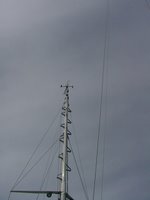 My decision to never again have a diesel generator aboard, as for me, it was too noisy, costly to install and was another maintenance issue. This decision has never been regretted. Even to microwave some h
My decision to never again have a diesel generator aboard, as for me, it was too noisy, costly to install and was another maintenance issue. This decision has never been regretted. Even to microwave some h ot chocolate meant firing up the beast. Enough! I read what I could find on the subject in the 80's and thought I understood the technology of the times. My plan was for a 2 bladed, Four Winds Wind Generator (their most powerful and rated tops by Practical Sailor) atop my mizzen mast.
ot chocolate meant firing up the beast. Enough! I read what I could find on the subject in the 80's and thought I understood the technology of the times. My plan was for a 2 bladed, Four Winds Wind Generator (their most powerful and rated tops by Practical Sailor) atop my mizzen mast.Wind Generator atop Mizzen Mast................. 5 amps brought smiles
Later on adding some solar panels, when the technology was refined. A 150 amp. alternator and smart external regulator was installed first so that anytime I started the engine, maximum power was put back into the battery bank.
The Four Winds wind generator was installed in '94 and removed in '05.............
Dave McCampbell of SoggyPaws was also moored in Boot Key Harbor, near me, in '05. He had this habit ....of passing by in his inflatable and looking up at my slow moving wind generator and asking, "When are you going to solar Ron?"..Smiling, he would continue by....still looking up..... (he was gentle with his proding.)
I finally asked myself the same question after realizing that in any month, we enjoyed enough wind to satisfy my batteries 'maybe' 3 days of 30. It was sunny for the other 27. So, "Why was I or anyone, accepting the negative 9:1 ratio?" I started to research Solar on the internet and put my Wind Generator up for sale on Ebay.
Dave had 410
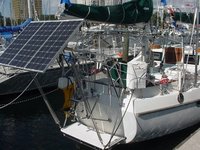 amp hours of older solar panels on his stern arch. My system would need about 500 I thought, as we do not wish to be frugal if power is available and considering the inefficiencies of the 'locations' I would use aboard, mostly caused by shading of the 3 panels over the aft cockpit. Mizzen mast, mizzen boom, it's furled sail, rigging and radar dome, would all cause shading of the 3 panels atop the cockpit, but usually not those over the davits.
amp hours of older solar panels on his stern arch. My system would need about 500 I thought, as we do not wish to be frugal if power is available and considering the inefficiencies of the 'locations' I would use aboard, mostly caused by shading of the 3 panels over the aft cockpit. Mizzen mast, mizzen boom, it's furled sail, rigging and radar dome, would all cause shading of the 3 panels atop the cockpit, but usually not those over the davits..................................Adjustable panels on davit system
3 panels would be mounted atop a very robust set of davits originally designed to incorporate the solar array. Too much energy would be O
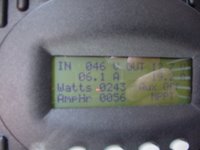 K, but not enough ever is, so I used 'technology'. We are lucky now that it is available, useing software/algorithms to manipulate the volt/amp equations to boost output as much as 10-30%. This new technology is called MPPT (Maximum Power Point Technology)
K, but not enough ever is, so I used 'technology'. We are lucky now that it is available, useing software/algorithms to manipulate the volt/amp equations to boost output as much as 10-30%. This new technology is called MPPT (Maximum Power Point Technology)http://www.outbackpower.com/MX60.htm
(click on photo to enlarge it)
and adjusts the VA's (watts) equation to best pump up the batteries even when conditions are cool or cloudy, as well as low angles of sunlight during the early or late hours of the day.
Outback Solar Controller-with 4 line readout-(click to enlarge) and notice the 46V input and do not miss.....the amps in.. and out.
I chose an 'Outback' Controller with the optional battery temperature sensor for fine tuning the charge. One of the features of this system is the ability to Input up to 70 amps of solar power(some overkill is highly recommended). Our panels are Shell(formerly Siemens) 85watt, 17 volt, 5 amp. Some controllers, like the Outback can take higher voltages and step them down to the configuration of your 12, 24 or 48 volt batteries. An advantage here is to set up your panels with a higher voltage Input than the batteries require. Voltage is the force that makes things happen. If your battery bank is at 12.2 volts and in early morning and your panels are at 12.3, you will not have enough force to up your battery voltage as the panels 'wake up'. Hook up your 3 panels in series, rather than parallel and now you have up to 50+volts of input driving electricity into a 12.2 volt battery bank-through the controller-and the batteries will definitely rise. (A side benefit is smaller gauge wiring for the distance needed-if you need to skimp on this.)I set up 2 arrays of 3 panels each and wired them in series to utilize the 17 volts of each panel, lined up, to deliver 50+ volts to the Controller. The result is the extra boost in performance that this new technology can give..(check on all available Controller manufacturers for your needs.) It should also be mentioned that if you have an efficient solar charging system that will offer the amps all day, that a battery system should be matched to that 'long, slow input, for a longer life. The VRLA batteries such as gell and agm's offer the no maintenance feature and deal with the short cycling very well. Dave McCampbell is doing some extra research on this and I'll update the battery info when he feels satisfied. There is no need for golf cart batteries or the heavy duty rolls style for this gentle application, as they will not be drawn down to an 80% discharge.
For 5 months after installation of only 3 panels(albeit those were adjustable to face the sun more often); those 3 panels seemed to satisfy 90% of our needs living aboard. The last 3 panels were then added atop the new bimini structure and we now have our batteries in "Float" by early afternoon. Keep in mind, that getting into "float" is normally the hardest 15% of recharging a battery bank.
No more Wind generator noise, vibration, maintenance. Silence...................[written Nov 24, 2006]
[Updated, Jun28, 2011]
However! Returning now after about 3 years in the tropics of Panama, I have a refined view of needs.
Note: If you are augmenting your power input from moving your boat often, then you can disregard this, but if you stay put often... then, consider this:
Often there is not enough sun. This is common during 'Rainy' season in the tropics, which can last for 6 months. What do you do then?? Well, wind generation sure helps many boats. It will put out something day or night. Maybe only incrementally, but it's a big advantage to have BOTH Solar AND Wind. I added another item to the list 2 years ago, one also used by Dave on Soggypaws, when he ventured past the Panama Canal and found himself in cloudy sky's on windless conditions.......and that is a small Honda generator..
I chose a Honda eu2000i for it's output, quiet performance and meager fuel consumption, using it's ECO mode.
If your going to go cruising, try to fill ALL the baskets with the tools you will need. I suggest a large battery bank of 700-1000 A.H.'s, Solar of at least 500 Watts, a Wind generator that does not disturb you and a small Honda Generator with maybe a half dozen Plastic Fuel Tanks full of strait gasoline. (We put those 5 gallon tanks 2 each, in 18 gallon Rubbermaid storage containers, on side and aft decks, tied down. The Rubbermaids kept the sun and roaming eyes off) If we needed fuel for our 2 stroke outboard, we would then add oil to the outboards tank at each fill, this way, keeping our options open for use of gasoline for both Generator or Outboard.
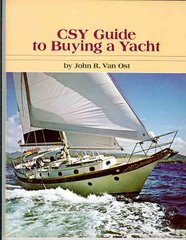
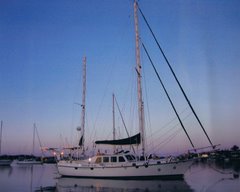
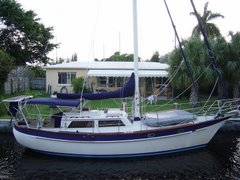
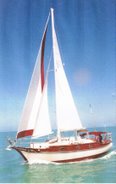
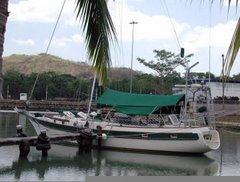
4 comments:
Ron, I am about to purchase new batteries after having just installed 3 solar panels with a total power rating of 390 watts. I would like / have room for, ~ 660-880 amp hours of battery capacity depending on battery geometry. I too would like to eliminate the maintenance associated with flooded batteries. I read here you went with gel batteries. Did you need to revise your alternator regulator charge cyle? Now that you have been living with the gels for awhile, how do you feel about gel vs. AGM? Most importantly, any specific recommendation about which batteries to buy?
How did the storm treat you down there?
Thank you once again
Steve Gould
Soverel 48
S/V Broad Reaching
Hello Steve, I know I answered this privately, but forgot to add it here! Sorry folks.
I have used gells on and off for 16 years with two tries of AGM's. I think they are both great, but each has some benefits as well as potential weak spots.
Gells are really tempermental when it comes to charging and voltage! IF you use a good regulator and pay attention, they will do fine.
AGM's are tougher and can take misuse in charging or depletion. However, in my research, the Gells have 2x the life cycles if lightly depleted. Since we have 900 amp hours of batteries in our house bank and only pull it down less than 10% during a night, the gells should last twice as long as AGM's.
Hello Ron, I am wondering what is the "Hotel" load of your boat during the day vice night time. Do the Gel batteries require a deep discharge and then an equalization charge (as would be the case for traditional water filled batteries).
Ed Casas
Wannabe CSY 44 owner
P.S.
Very informative article. Thank-you for writing it.
Hello Ed,
I designed this boats systems to 12 volt advantage. I knew I/we, would someday be away cruising and did not want the aggrivation of being tied to the ritual of running a big engine to power a small compressor and anternator. Also wanted a system where the boat could be left for days or weeks without being concerned if the food would spoil or the bilge pumps would fail etc. Refrigeration is the biggest deamon on a boat when it comes to consumption of power. Away from the dock there are really only 2 choices, a combustion engine power source/engine or gen set, or 12vdc. I chose batteries and know there are many advantages to wet cells,(cost/longevity/availability) but I needed to put them in a location that was going to make maintanace a nightmare. Therefore, nightmare was removed by going to Non Maintance Batteries. Our daily consumption can be less than a hundred or 250 AH./day depending on how much lighting, TV/DVD, computer time(ususally 2)we use each day.
The Gells and AGMs both are maintanace free, but at the last minute this time I decided to go back to East Penn Manufacturing site (they make most of the gells in the US as well as plenty of AGM's) Their PDF info showed nearly twice the number of Life Cycles on Gells, if only pulled down a small amount. I expect over the long term to only draw my house bank down 10-20% daily, so that fits! Twice the Number of Life Cycles is good news to my ears.
Lastly, I do not equalize the Gells and did not for the AGMS either, as per East Penn instructions.
Glad you enjoyed the write-up.
Post a Comment